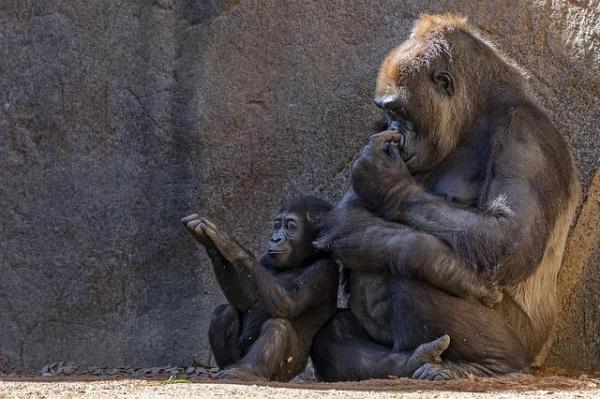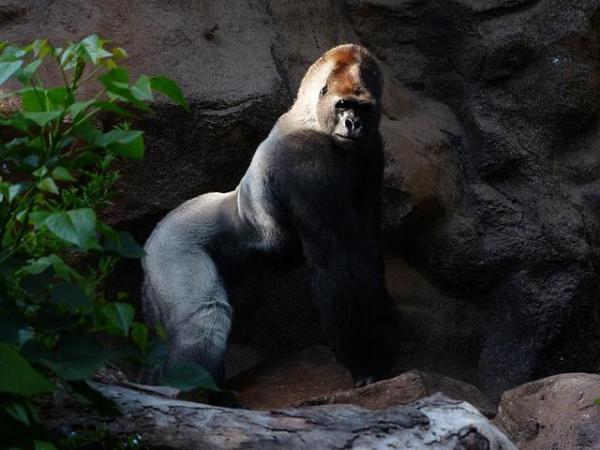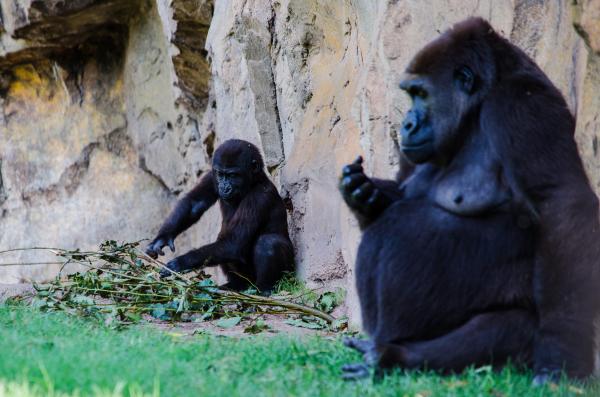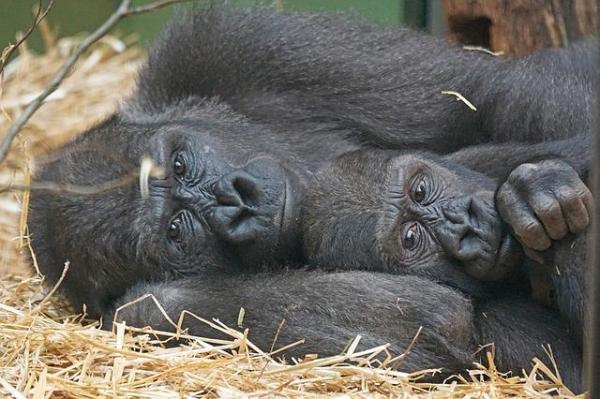
There is no doubt that gorillas, the largest living primates, are fascinating creatures that have captured the attention of many scientists and enthralled many nature enthusiasts for decades. With their impressive size and strength, gorillas play an important ecological role in their habitats by helping to disperse seeds and maintain forest health. Gorillas also have a complex social structure, with close-knit family groups and social hierarchies.
In the following AnimalWised article, we will explore the fascinating world of gorilla reproduction, including their mating habits, reproductive physiology, pregnancy and birth.
Reproduction of gorillas
Gorillas are the largest living primates and closely related to humans. They share about 98% of our DNA. There are two species of gorillas, both native to the forests of Central Africa. These are:
- Eastern Gorilla (Gorilla beringei)
- Western Gorilla (Gorilla gorilla)
Gorillas are herbivores and consume a variety of plants, including fruits, leaves, stems, and flowers. They play an important ecological role in their habitats by helping to disperse seeds and maintain forest health.
Like humans, gorillas reproduce slowly. They give birth to only one baby at a time and then raise it for several years before giving birth again. This slow reproductive rate makes gorillas particularly vulnerable to population decline.
Challenges to gorillas reproduction
Gorilla reproduction faces a number of challenges that threaten its survival as a species. Some of these challenges are:
- Habitat loss: mostly due to deforestation, agriculture, and mining, habitat loss can fragment gorilla populations and limit their access to suitable mates.
- Poaching: which reduces the number of male gorillas and also disrupts complex group social dynamics.
- Climate change: also affects gorilla reproduction by altering food and water availability and increasing the incidence of disease.
These challenges highlight the importance of efforts to protect gorilla populations and their habitats.
How do gorillas mate?
Gorilla mating habits can vary by species and population, but it is usually polygynous, meaning that a single male mates with several females within his group. This behavior is also referred to as harem polygyny.
The mating habits of gorillas are complex and include a range of behaviors, vocalizations, and displays. Mating can occur throughout the year, but females are sexually receptive only a few days each month. Male gorillas, on the other hand, can mate year-round due to their constant level of reproductive hormones.
Social bonds play a critical role in the mating habits of gorillas. Female gorillas generally mate with the dominant male within their group to ensure the survival of their offspring. Male gorillas often display their dominance and call loudly to attract females. However, social bonds may also develop between males and females through grooming, sharing food, and other behaviors. These social bonds can lead to more consensual mating and a more harmonious social structure within the gorilla group.
Do gorillas mate for life?
No, gorillas do not mate for life. Social gorilla groups consist of a dominant male, several females, and their offspring. The dominant male may mate with several females in the group, and the females may also mate with several males. Gorilla social groups are not permanent, and females may leave the group to join other groups or be taken over by new males.
Be sure to check out the related article to learn more about gorillas and the various species that exist.

How do gorillas reproduce?
Gorillas reproduce sexually, with a male gorilla mating with a receptive female gorilla. Female gorillas do not have a menstrual cycle or go into heat, unlike many other mammals.
The reproductive cycle of female gorillas usually lasts about 30 to 32 days, although it may vary somewhat from individual to individual. During the cycle, the female undergoes hormonal changes that result in the development of an egg in the ovary, which is then released into the fallopian tube where it may be fertilized by sperm.
If fertilization does not occur, the endometrium is reabsorbed and not shed during the menstrual cycle, as in humans. Female gorillas are sexually receptive for only a few days each month. During this time, they are fertile and can become pregnant.
Male gorillas, on the other hand, have a constant level of reproductive hormones that allows them to mate throughout the year. Testosterone is the most important hormone in the reproductive physiology of male gorillas and is responsible for the development of secondary sexual characteristics and the production of sperm.

How is gorilla pregnancy and birth?
The gestation period in gorillas is approximately 8.5 months, similar to humans. During this time, the mother undergoes significant physiological changes to support fetal growth and development. For example, her body produces more blood to provide oxygen and nutrients to the developing fetus, and her uterus expands to support fetal growth.
Female gorillas are very maternal and invest a great deal of time and energy in caring for their offspring. During pregnancy, they become increasingly withdrawn and spend more time building nests and preparing for birth. After birth, they swaddle and nurse their children, caring for them and keeping them close for several years.
Gorilla births usually occur during the day and are usually relatively quick and uneventful, lasting only 30-60 minutes. The gorilla mother often chooses a secluded location for the birth and may even build a special nest for the occasion.

Gorillas and their young
Gorilla infants are born relatively helpless, with closed eyes and weak limbs, and weigh about 3–4 pounds. Gorilla infants depend on their mothers for survival and nurse for several years. The mother carries the infant on her stomach for the first few months of life, and the baby gorilla learns to cling to its mother's hair at 1 to 2 months of age. After a year, the young follows the mother for short distances on its own feet, but still remains within sight of the mother.
As they grow older, they become more independent, exploring their environment and learning from their mothers and other group members. Female gorillas reach sexual maturity at about 7–8 years of age, while male gorillas reach sexual maturity at about 11–12 years of age.
Interaction between mother and calf is critical to the infant's development and socialization, and as they grow older, they begin to play with other members of the group.
The males in the group also play a protective role, defending both the females and the young against any danger.
How many offspring do gorillas have?
Female gorillas usually give birth to only one young at a time. Twins are extremely rare, and there are few documented cases of twin births in gorillas.
Did you know that gorillas are among the strongest animals in the world? Learn more about the amazing strength of gorillas in this other article.

If you want to read similar articles to How Do Gorillas Reproduce?, we recommend you visit our Endangered animals category.
- Abello, M. (2010). Incident factors in the reproduction and development of primates in captivity: "ex situ" conservation of western gorillas (Gorilla gorilla) . PhD Thesis, University of Barcelona. Available at: https://www.tdx.cat/bitstream/handle/10803/52079/MTAP_TESIS.pdf;jsessionid=484B8DBF0ED3F134E172B5996448B5D9?sequence=1
- Csomos, R. (2008). Gorilla . Animal Diversity Web. University of Michigan, Museum of Zoology. Available at: https://animaldiversity.org/accounts/Gorilla_gorilla/
- Lindsley, T. & Sorin, A. (2001). Gorilla beringei . Animal Diversity Web. University of Michigan, Museum of Zoology. Available at: https://animaldiversity.org/accounts/Gorilla_beringei/